

We will assume all forces except gravity (such as air resistance and friction, for example) are negligible. We must find their components along the x– and y-axes, too. Of course, to describe motion we must deal with velocity and acceleration, as well as with displacement. (Note that in the last section we used the notation to represent a vector with components and If we continued this format, we would call displacement with components and However, to simplify the notation, we will simply represent the component vectors as and. The magnitudes of these vectors are s, x, and y. Figure 1 illustrates the notation for displacement, where is defined to be the total displacement and and are its components along the horizontal and vertical axes, respectively. (This choice of axes is the most sensible, because acceleration due to gravity is vertical-thus, there will be no acceleration along the horizontal axis when air resistance is negligible.) As is customary, we call the horizontal axis the x-axis and the vertical axis the y-axis. The key to analyzing two-dimensional projectile motion is to break it into two motions, one along the horizontal axis and the other along the vertical.


This fact was discussed in Chapter 3.1 Kinematics in Two Dimensions: An Introduction, where vertical and horizontal motions were seen to be independent. The most important fact to remember here is that motions along perpendicular axes are independent and thus can be analyzed separately. In this section, we consider two-dimensional projectile motion, such as that of a football or other object for which air resistance is negligible. The motion of falling objects, as covered in Chapter 2.6 Problem-Solving Basics for One-Dimensional Kinematics, is a simple one-dimensional type of projectile motion in which there is no horizontal movement. The object is called a projectile, and its path is called its trajectory. Projectile motion is the motionof an object thrown or projected into the air, subject to only the acceleration of gravity. Apply the principle of independence of motion to solve projectile motion problems.Determine the location and velocity of a projectile at different points in its trajectory.Identify and explain the properties of a projectile, such as acceleration due to gravity, range, maximum height, and trajectory.


 0 kommentar(er)
0 kommentar(er)
